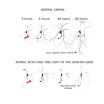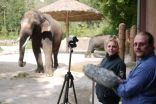(Press-News.org) High blood cholesterol, a serious hereditary disease, is far more common than previously recognised and not treated sufficiently. This is shown in new research from the University of Copenhagen and Herlev Hospital, and the results have recently been published in the well-reputed American scientific journal, The Journal of Clinical Endocrinology & Metabolism.
A group of scientists from the University of Copenhagen has recently shown that far more Danes than expected suffer from high blood cholesterol. The study also shows that the serious hereditary disease is not treated effectively.
Dr Børge Nordestgaard, clinical professor at the Faculty of Health and Medical Sciences and senior physician at Herlev Hospital is surprised at the findings.
"We have now investigated 69,000 Danes to see how many have hereditary high blood cholesterol and have undergone sufficient treatment for the disease. We can see that out of 137 people in Denmark 1 has hereditary high blood cholesterol. That corresponds to 40,000 people with the disease in the Danish population of 5.5 million," states Børge Nordestgaard.
The study also shows that very few families and individuals with this serious disease have been identified and treated effectively with statins, a type of drug for treating high cholesterol. In Holland, by comparison, early detection of patients and their families has almost eliminated the increased risk of coronary disease, because effective treatment to reduce cholesterol levels was implemented quickly.
"Never before anywhere in the world has the ordinary population been studied to see how many people and families with hereditary high blood cholesterol there actually are. It was previously assumed that only 1 out of every 500 people had it, so it was quite a surprise for us suddenly to find 3 ½ times as many people with this serious disease. At the same time, it was also startling to discover that a disease that can easily be prevented by treatment to reduce blood cholesterol has not been treated sufficiently," says Dr. Marianne Benn, senior physician, also from the University of Copenhagen.
Underdiagnosis and undertreatment
Of those Danes shown to have hereditary high blood cholesterol, one-third already had coronary disease, and only half were being treated with statins. People with hereditary high blood cholesterol not undergoing treatment with statins have a 1,200 per cent higher risk of developing coronary disease. Even more surprising: people with hereditary high blood cholesterol who are being treated with statins still have a 900 per cent higher risk of incurring coronary disease. In total, the study documents massive underdiagnosis and undertreatment of these high-risk individuals and their families in Denmark.
Researchers used the internationally recognised Dutch criteria for hereditary high blood cholesterol based on very high blood cholesterol level and early-onset coronary disease in the test person and his/her family, and on the finding of mutations that directly lead to hereditary high blood cholesterol. The increased risks appear even when figures are adjusted for several other factors that also contribute to coronary disease. Researchers use this method to eliminate biased results.
50 million people with hereditary high blood cholesterol
These new figures mean that there are about 50 million people worldwide with hereditary high blood cholesterol. Today most of these people are undiagnosed, untreated and therefore at serious risk of dying early from coronary disease. According to the World Health Organization (WHO), coronary disease is the most common cause of death in adults worldwide. WHO estimates that at least 17 million people die from coronary disease annually. A considerable number of these deaths are due to hereditary high blood cholesterol.
"We have known for decades about high blood cholesterol and how to prevent it. Nonetheless the disease is massively underdiagnosed and undertreated. This means that many people unnecessarily develop early-onset coronary disease and die far earlier than normal," says Børge Nordestgaard.
Now scientists are continuing their work to determine how many of the people with hereditary high blood cholesterol can be demonstrated to have a mutation that causes the disease, so that it will be easier to trace the families with this problem.
###
Read the scientific article "Familial Hypercholesterolemia in the Danish General Population: Prevalence, Coronary Artery Disease, and Cholesterol-Lowering Medication" in the reputed journal, The Journal of Clinical Endocrinology & Metabolism. Doi: 10.1210/jc.2012-1563
Contact
Professor Børge Nordestgaard
Telephone: +45 3868 3297
Mobile: +45 3028 7263
Facts about the study
The study was conducted in collaboration between Professor Anne Tybjærg-Hansen, M.D. from the University of Copenhagen and Professor Gerald Watts, M.D. from the University of Western Australia.
The results are from the Herlev/Østerbro Study based on randomly selected individuals from the general Danish population. Cholesterol level was measured for all participants, and they were asked about their statin consumption and their family members. All participants were followed in the Danish register from 1977 to today with focus on coronary disease.
Cholesterol figures were gathered from a total of 69,000 Danes.
High blood cholesterol is overlooked
High blood cholesterol, a serious hereditary disease, is far more common than previously recognized
2012-11-01
ELSE PRESS RELEASES FROM THIS DATE:
UC Santa Barbara scientists learn how to unlock the destiny of a cell: A gift for the tin man?
2012-11-01
(Santa Barbara, Calif.) –– Scientists have discovered that breaking a biological signaling system in an embryo allows them to change the destiny of a cell. The findings could lead to new ways of making replacement organs.
The discovery was made in the laboratory of Joel H. Rothman, a professor in the Department of Molecular, Cellular, and Developmental Biology at UC Santa Barbara. The studies were reported in the interdisciplinary journal Genes and Development, and were carried out by Ph.D student Nareg Djabrayan, in collaboration with Rothman and two other members of ...
How race and touchdown celebrations affect football player rewards
2012-11-01
The post-touchdown celebration is a familiar part of many football games. However, new research from the Kellogg School of Management at Northwestern University suggests that black players may be more likely than white players to be penalized for putting their feelings on display.
As a part of the study, Kellogg Ph.D. candidate Erika V. Hall and Professor Robert Livingston first analyzed all of the unsportsmanlike conduct penalties by NFL athletes during the entire 2010-2011 NFL season. Unsportsmanlike conduct includes the excessive celebration penalty. They found that ...
Cellular landscaping: Predicting how, and how fast, cells will change
2012-11-01
A research team at the National Institute of Standards and Technology (NIST) has developed a model* for making quantifiable predictions of how a group of cells will react and change in response to a given environment or stimulus—and how quickly. The NIST model, in principle, makes it possible to assign reliable numbers to the complex evolution of a population of cells, a critical capability for efficient biomanufacturing as well as for the safety of stem cell-based therapies, among other applications.
The behavior and fate of cells are only partially determined by their ...
New discovery shows promise in future speed of synthesizing high-demand nanomaterials
2012-11-01
NORMAN, Okla. – A new discovery by University of Oklahoma and North Carolina State University researchers shows a breakthrough in speeding up the process for synthesizing transition metal oxide nanostructures. What had once taken days can now be accomplished instantaneously.
After previous success using an oxygen-enriched flame to synthesize common nanomaterials, such as carbon nanotubes, nanofibers and fullerenes, OU College of Engineering professor Wilson Merchán-Merchán and his team conducted experiments using the same method to create a new form of nanostructures. ...
Study finds that adding soy to the diet does not affect onset of menopausal hot flashes
2012-11-01
(SACRAMENTO, Calif.) — A team of investigators led by UC Davis found that eating soy products such as soy milk and tofu did not prevent the onset of hot flashes and night sweats as women entered menopause.
Unlike previous studies investigating the relationship between soy and these menopausal symptoms, the current study included a very large population over a long period of time: more than 1,600 women over 10 years.
The article, titled "Phytoestrogen and Fiber Intakes in Relation to Incident Vasomotor Symptoms: Results from the Study of Women's Health Across the Nation," ...
Gene required for nerve regeneration identified
2012-11-01
A gene that is associated with regeneration of injured nerve cells has been identified by scientists at Penn State University and Duke University. The team, led by Melissa Rolls, an assistant professor of biochemistry and molecular biology at Penn State, has found that a mutation in a single gene can entirely shut down the process by which axons -- the parts of the nerve cell that are responsible for sending signals to other cells -- regrow themselves after being cut or damaged. "We are hopeful that this discovery will open the door to new research related to spinal-cord ...
A glimpse into neurosurgical risk prevention and the surgical checklist
2012-11-01
Charlottesville, VA (November 1, 2012). The November issue of Neurosurgical Focus is dedicated to lessening the number and severity of adverse events surrounding neurosurgical intervention for a variety of disorders. Guest editors Alexander Khalessi (University of California, San Diego), James Forrest Calland (University of Virginia), Gabriel Zada (University of Southern California), and Michael Y. Wang (University of Miami Health System) selected 16 articles on systems-based quality improvement for neurosurgical procedures.
The articles are divided into four major subtopics: ...
An elephant that speaks Korean
2012-11-01
An Asian elephant named Koshik can imitate human speech, speaking words in Korean that can be readily understood by those who know the language. The elephant accomplishes this in a most unusual way: he vocalizes with his trunk in his mouth.
The elephant's vocabulary consists of exactly five words, researchers report on November 1 in Current Biology, a Cell Press publication. Those include "annyong" ("hello"), "anja" ("sit down"), "aniya" ("no"), "nuo" ("lie down"), and "choah" ("good"). Ultimately, Koshik's language skills may provide important insights into the biology ...
JCI early table of contents for Nov. 1, 2012
2012-11-01
Congenital diarrheal disorder linked to a mutation in DGAT1
Congenital diarrheal disorders (CDD) are a group of rare intestinal diseases that are caused by genetic mutations. In a study published in the Journal of Clinical Investigation, Robert Farese and colleagues at the University of California, San Francisco, identified a family with two of three children affected by CDD. The affected children both carried a rare mutation in the DGAT1 gene. DGAT1 mediates the formation of triglycerides and is being assessed as a therapeutic target in the treatment of obesity. The study ...
Congenital diarrheal disorder linked to a mutation in DGAT1
2012-11-01
Congenital diarrheal disorders (CDD) are a group of rare intestinal diseases that are caused by genetic mutations. In a study published in the Journal of Clinical Investigation, Robert Farese and colleagues at the University of California, San Francisco, identified a family with two of three children affected by CDD. The affected children both carried a rare mutation in the DGAT1 gene. DGAT1 mediates the formation of triglycerides and is being assessed as a therapeutic target in the treatment of obesity. The study by Farese's group suggests that targeting of DGAT1 could ...
LAST 30 PRESS RELEASES:
AI-based tool predicts future cardiovascular events in patients with angina
Researchers map how the cerebellum builds its connections with the rest of the brain during early development
Routine scans could detect early prostate radiotherapy changes
Fairness in AI: Study shows central role of human decision-making
Pandemic ‘beneath the surface’ has been quietly wiping out sea urchins around the world
Tea linked to stronger bones in older women, while coffee may pose risks
School feeding programs lead to modest but meaningful results
Researchers develop AI Tool to identify undiagnosed Alzheimer's cases while reducing disparities
Seaweed based carbon catalyst offers metal free solution for removing antibiotics from water
Simple organic additive supercharges UV treatment of “forever chemical” PFOA
£13m NHS bill for ‘mismanagement’ of menstrual bleeds
The Lancet Psychiatry: Slow tapering plus therapy most effective strategy for stopping antidepressants, finds major meta-analysis
Body image issues in adolescence linked to depression in adulthood
Child sexual exploitation and abuse online surges amid rapid tech change; new tool for preventing abuse unveiled for path forward
Dragon-slaying saints performed green-fingered medieval miracles, new study reveals
New research identifies shared genetic factors between addiction and educational attainment
Epilepsy can lead to earlier deaths in people with intellectual disabilities, study shows
Global study suggests the underlying problems of ECT patients are often ignored
Mapping ‘dark’ regions of the genome illuminates how cells respond to their environment
ECOG-ACRIN and Caris Life Sciences unveil first findings from a multi-year collaboration to advance AI-powered multimodal tools for breast cancer recurrence risk stratification
Satellite data helps UNM researchers map massive rupture of 2025 Myanmar earthquake
Twisting Spins: Florida State University researchers explore chemical boundaries to create new magnetic material
Mayo Clinic researchers find new hope for toughest myeloma through off-the-shelf immunotherapy
Cell-free DNA Could Detect Adverse Events from Immunotherapy
American College of Cardiology announces Fuster Prevention Forum
AAN issues new guideline for the management of functional seizures
Could GLP-1 drugs affect risk of epilepsy for people with diabetes?
New circoviruses discovered in pilot whales and orcas from the North Atlantic
Study finds increase in risk of binge drinking among 12th graders who use 2 or more cannabis products
New paper-based technology could transform cancer drug testing
[Press-News.org] High blood cholesterol is overlookedHigh blood cholesterol, a serious hereditary disease, is far more common than previously recognized


